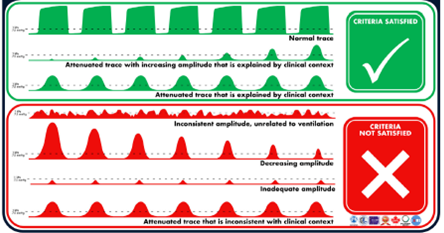Sustained Exhaled CO2
In 2018 the RCoA launched “no trace, wrong place” to address misunderstanding about what would be seen on a capnograph in the event of cardiac arrest. The phase was useful when a flat CO2 trace is encountered but it has become apparent that there are several problems with its use. Due to this, the term ‘sustained exhaled CO2’ was coined as part of the development of the Guidelines for Prevention of Unrecognised Oesophageal Intubation, led by the Project for Universal Management of Airways (PUMA) and published in 2022.
What is sustained exhaled CO2 ?
The requirement for sustained exhaled CO2 to exclude oesophageal intubation is clearly defined, unlike no trace wrong place. The rationale for each criterion is discussed in the paper. Importantly ‘sustained exhaled CO2’ overcomes the majority of limitations of no trace wrong place: it triggers a check of tube position when a trace is present but diminishing, low amplitude, abnormal or wrong for the clinical context and it applies equally during and outside cardiac arrest. It also encompasses no trace wrong place, as a flat trace will not meet any of the four criteria. Thus if ‘sustained exhaled CO2’ is adopted there is no longer any need for ‘no trace wrong place'.
The criteria for sustained exhaled CO2 are
- A level that rises with exhalation and falls during inspiration;
- Consistent or increasing in amplitude over at least seven breaths;
- Having a peak amplitude >1 kPa (7.5 mm Hg) above baseline;
- Being clinically appropriate.
If these criteria are not met, teams are obliged to exclude oesophageal intubation. Examples of CO2 traces that do and do not meet the criteria are shown in the figure.

These guidelines are internationally supported. Importantly in the UK they are supported or endorsed by
- Royal College of Anaesthetists
- Faculty of Intensive Care Medicine
- Association of Anaesthetists
- Intensive Care Society
- Difficult Airway Society
- College of Operating Department Practitioners
This is a wider level of support than any other airway guidelines. There is an argument these are therefore de facto national guidelines.
In the most recent prevention of future deaths letter to the RCoA after fatal unrecognised oesophageal intubation – for Joseph Parker a previously healthy 18 year-old – the coroner wrote “The PUMA guidance deserves the widest possible endorsement and dissemination which has not happened”.
There is evidence we are not winning in the battle to eradicate unrecognised oesophageal intubations. The RCoA continues to receive multiple coronial Prevention of Future Deaths letters. NAP4, received nine cases, four during anaesthesia, but NAP7 received six reports during anaesthesia, four leading to cardiac arrest.
In excluding oesophageal intubation, ‘No trace wrong place’ played role, but it is insufficient and is now causing confusion. Adopting ‘sustained exhaled CO2’ overcomes these issues.
